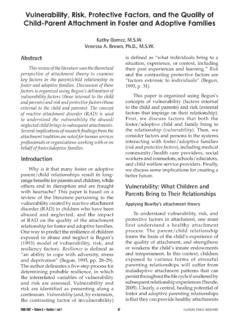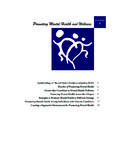Transcription of Risk factors for road traffic injuries - who.int
1 Unit 2. RISK factors FOR ROAD traffic injuries 2211 Risk factors for road traffic injuriesUNIT 2 Overview Objectives Analytical frameworks Public health approach Haddon matrix Systems approach Activity What are the main risk factors ? factors influencing exposure to risk factors influencing crash involvement factors influencing crash severity factors influencing post-crash injury outcomes Key points Definitions of key concepts Questions to think about References Further reading Notes Trainee s evaluationunit-2 11/3/2006 6:22 PM Page 21unit-2 11/3/2006 6:22 PM Page 22 Unit 2.
2 RISK factors FOR ROAD traffic injuries 2233 Analytical frameworksVarious analytical frameworks can be used toidentify the risk factors involved in road trafficinjuries. In this section, we present threeframeworks or approaches: the public healthapproach; the Haddon matrix; and the systemsapproach. Public health approachThe public health approach is a generic analyticalframework that has made it possible for differentfields of public health to respond to a wide range ofhealth problems and diseases, including injuriesand violence (1, 2).
3 This approach is not onlyhelpful in the analysis of risk factors , but alsoprovides a framework that guides decision-makingthroughout the entire process, from identifying aproblem to implementing an intervention. Analysisof risk factors is one of the components of thisapproach, and that is why we have included it herefor application to road traffic injuries . The public health approach involves fourinterrelated steps (Figure ): The first step is to determine the magnitude,scope and characteristics of the the problem goes beyond simplycounting cases: it includes delineating mortality,morbidity, and risk-taking behaviour.
4 In the caseof road traffic injuries , this step includesobtaining information on the demographiccharacteristics of the people involved, thetemporal and geographical features of theincident, the circumstances under which itoccurred, and the severity and cost of theinjuries. Quantitative (for example, surveys) andqualitative (for example, focus groupOverviewroad traffic crash results from acombination of factors related to thecomponents of the system comprising roads, theenvironment, vehicles and road users, and theway they interact.)
5 Some factors contribute to theoccurrence of a collision and are therefore part ofcrash causation. Other factors aggravate theeffects of the collision and thus contribute totrauma severity. Some factors may not appear tobe directly related to road traffic injuries . Somecauses are immediate, but they may beunderpinned by medium-term and long-termstructural causes. Identifying the risk factors thatcontribute to road traffic crashes is important inidentifying interventions that can reduce therisks associated with those unit is devoted to discussing riskfactors for road traffic injuries .
6 The first part ofthe unit provides frameworks that can be used toidentify and analyse risk factors . The second partdiscusses the key risk the end of this unit, the trainee should be ableto: discuss the basic elements of the public healthapproach and Haddon matrix; apply the principles of a systems approach tothe analysis of risk factors for road trafficinjuries; discuss the key risk factors for road trafficinjuries; relate these risk factors to the trainee s owncountry, region and The public health approachunit-2 11/3/2006 6:22 PM Page 232244 ROAD traffic INJURY PREVENTION.
7 TRAINING MANUALTABLE The Haddon matrixFFAACCTTOORRSSPPHHAASSEEHHUUMMAANN VVEEHHIICCLLEESS AANNDD EEQQUUIIPPMMEENNTTEENNVVIIRROONNMMEENNTT Pre-crashCrash InformationRoadworthinessRoad design and road layoutpreventionAttitudes LightingSpeed limitsImpairmentBrakingPedestrian facilitiesPolice enforcementHandlingSpeed management CrashInjury prevention Use of restraintsOccupant restraintsCrash-protective roadside objectsduring the crashImpairmentOther safety devicesCrash protective designPost-crashLife sustainingFirst-aid skillEase of accessRescue facilitiesAccess to medicsFire ) research methods drawn from thebehavioural and social sciences are increasinglybeing used to identify and characterizeproblems.
8 The second step is to identify the factors thatincrease the risk of disease, injury or disability,and to determine which factors are potentiallymodifiable. Whereas the first step looks at who,when, where, what and how , the second steplooks at why . It may also be used to definepopulations at high risk for injuries and violenceand to suggest specific interventions. The third step is to assess what measures can betaken to prevent the problem by using theinformation about causes and risk factors todesign, pilot test and evaluate step aims at developing interventions basedupon information obtained from the previoussteps and testing these or other extantinterventions.
9 Methods for testing includerandomized controlled trials, controlledcomparisons of populations for occurrence ofhealth outcomes, cohort studies, time seriesanalyses of trends in multiple areas, andobservational studies such as case controlstudies. An important component of theevaluation step is to document the processes thatcontribute to the success or failure of anintervention, in addition to examining theimpact of interventions on health outcomes. The final step is the implementation ofinterventions that have been proven or are highlylikely to be effective on a broad scale.
10 In bothinstances it is important that data are collected toevaluate the programme s effectiveness inactually reducing road traffic injuries andfatalities, particularly since an intervention thathas been found effective in a clinical trial or asmall study may perform differently at thecommunity level, or when expanded to targetbroader populations or geographical important component is determining thecost-effectiveness of such the costs of a programme against thecases prevented by the intervention can be helpfulto policy-makers in determining optimal publichealth practice.
















